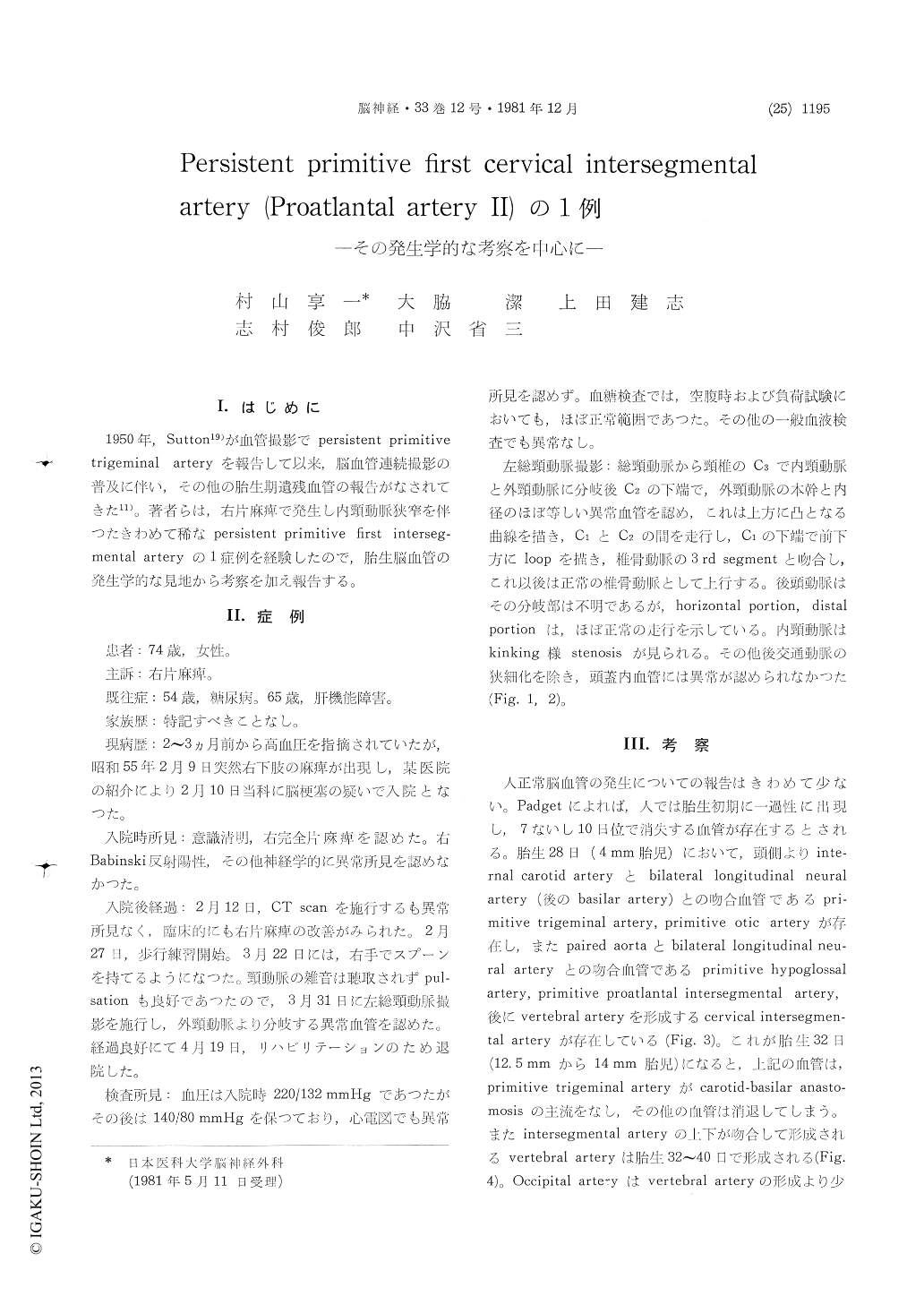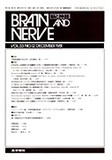Japanese
English
- 有料閲覧
- Abstract 文献概要
- 1ページ目 Look Inside
I.はじめに
1950年,Sutton 19)が血管撮影でPersistent Primitive trigeminal arteryを報告して以来,脳血管連続撮影の普及に伴い,その他の胎生期遺残血管の報告がなされてきた11)。著者らは,右片麻痺で発生し内頸動脈狭窄を伴つたきわめて稀なpersistent primitive first interseg—mental arteryの1症例を経験したので,胎生脳血管の発生学的な見地から考察を加え報告する。
A case of persistent primitive first cervical inter-segmental artery with a kinking stenosis of the internal carotid artery is reported.
A 74-year-old woman was admitted to our hospi-tal with right hemiparalysis. Several months earlier she had been diagnosed as having hypertension. She could not walk by herself due to weakness of her right leg. On admission, her general condition was relatively good and her blood pressure was 220 over 132 mmHg. Right hemiparalysis with no impairment of consciousness, and right Babinski's sign were noted. A CT scan was performed, but no abnormalities were detected. The right hemiparalysis began to recover due to intravenous injections of Urokinase and low-molecular weight dextran. The rehabilitation was begun 2 weeks after hospitalization and the patient was able to eat by herself 1 month later. Angiography was performed on the 50th day of hospitalization. The patient was then transferred to the rehabilitation center on her 70th day in the hospital.
Left carotid angiography revealed a kinking stenosis of the internal carotid artery and a large abnormal vessel connecting the external carotid artery and the vertebral artery. This anastomotic vessel arises from the left external carotid artery at the level of the 2nd cervical vertebra. It then curves slightly superiorly and posteriorly, and runs almost parallel horizontally with the 2nd cervical vertebral body. It next forms a loop posterior to the 2nd cervical vertebral body, and then merges with 3rd segment of the vertebral artery (Fig. 2).
This large anastomotic vessel is thought to be an anastomotic channel which normally disappears after the embryonic stage.
Lasjaunias et al. advanced a hypothesis about the development of the occipital artery in 1978. This hypothesis is a remnant of the first cervical inter-segmental artery, while the horizontal and distal portions of the occipital artery are remnants of the proatlantal intersegmental artery. However, Padget had already reported that the occipital artery de-velops only after the disappearance of these inter-segmental arteries. Lasjaunias's hypothesis thus appears to be incorrect. Recently, Suzuki put forth the more reasonable explanation that the develop-ment of the occipital artery was connected with disappearance of these intersegmental arteries. We support this theory. Moreover, Lasjaunias et al. classified the embryonic vessels of the intersegmen-tal arteries. They named these persistent inter-segmental arteries Proatlantal artery I and Proatlan-tal artery II (Fig. 6).
Recently, several cases of external carotid-verte-bral anastomosis have been reported. We investi-gated each anastomotic vessel in terms which part of the external carotid artery it arose from which vertebral body it passed through, and which portion of the vertebral artery it joined to. Based on those findings, these vessels can be classified accord-ing to Padget's and Lasjaunias's nomenclature(Table 1).
Our case is a very typical vessel that originates from the occipital artery, passes the cervical verte-bral body of the 2nd cervical vertebra, and connects with the 3rd segment of the vertebral artery. This vessel is classified as a persistent primitive first cervical intersegmental artery in accordance with Padget, or as Proatlantal artery II in accordance with Lasjaunias et al.

Copyright © 1981, Igaku-Shoin Ltd. All rights reserved.


